第八章金融市场
- 格式:ppt
- 大小:205.50 KB
- 文档页数:15

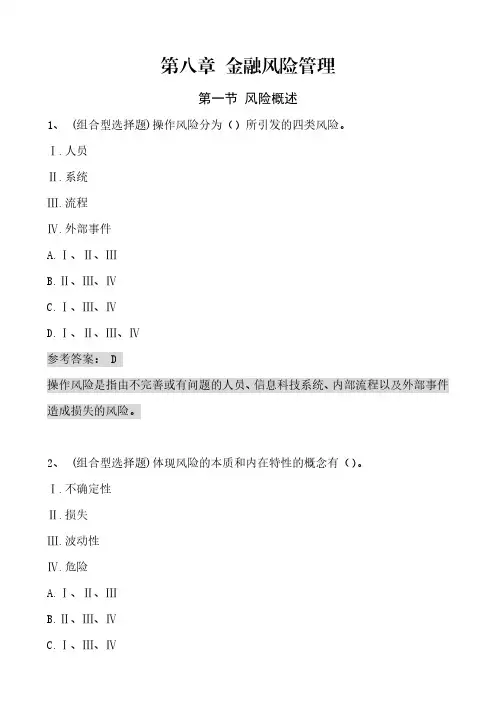
第八章金融风险管理第一节风险概述1、 (组合型选择题)操作风险分为()所引发的四类风险。
Ⅰ.人员Ⅱ.系统Ⅲ.流程Ⅳ.外部事件A.Ⅰ、Ⅱ、ⅢB.Ⅱ、Ⅲ、ⅣC.Ⅰ、Ⅲ、ⅣD.Ⅰ、Ⅱ、Ⅲ、Ⅳ参考答案: D操作风险是指由不完善或有问题的人员、信息科技系统、内部流程以及外部事件造成损失的风险。
2、 (组合型选择题)体现风险的本质和内在特性的概念有()。
Ⅰ.不确定性Ⅱ.损失Ⅲ.波动性Ⅳ.危险A.Ⅰ、Ⅱ、ⅢB.Ⅱ、Ⅲ、ⅣC.Ⅰ、Ⅲ、ⅣD.Ⅰ、Ⅱ、Ⅲ、Ⅳ参考答案: D体现风险的本质和内在特性的概念包括不确定性、损失、波动性(即对期望的偏离)和危险。
3、 (选择题)()是指金融市场参与者无法以合理成本及时获得充足资金,以偿付到期债务、履行其他支付义务和满足正常业务开展的资金需求的风险。
A.信用风险B.流动性风险C.市场风险D.操作风险参考答案: B流动性风险是金融机构面临的基本风险之一。
流动性风险,是指金融市场参与者无法以合理成本及时获得充足资金,以偿付到期债务、履行其他支付义务和满足正常业务开展的资金需求的风险。
4、 (选择题)基于()定义下风险的双向测度是现代风险管理发展的重要基础。
A.不确定性B.危险性C.损失性D.波动性参考答案: D基于波动性定义下风险的双向测度是现代风险管理发展的重要基础。
5、 (选择题)()是金融交易和风险管理行为的基本特征。
A.以风险换收益B.风险收益平衡选择C.风险和收益的二元结构D.风险与收益组合参考答案: B风险收益平衡选择是金融交易和风险管理行为的基本特征。
6、 (选择题)下列关于风险与波动性的说法中正确的是()。
A.在现代金融风险分析中,通常仅仅关注损失的可能性,是单向测度B.在波动性定义下,风险既是损失的可能,也是盈利的可能C.传统风险观认为,风险既是损失的来源,也是盈利的来源D.基于不确定性定义下风险的双向测度是现代风险管理发展的重要基础参考答案: B传统风险观仅仅关注损失的可能性,是单向测度。

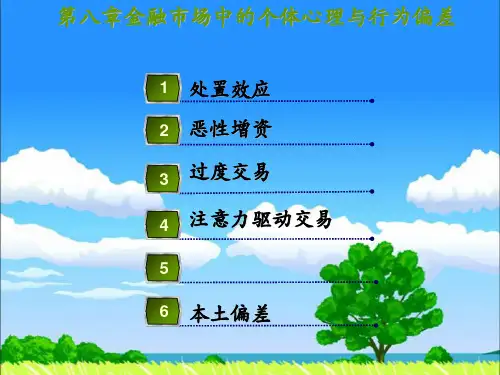
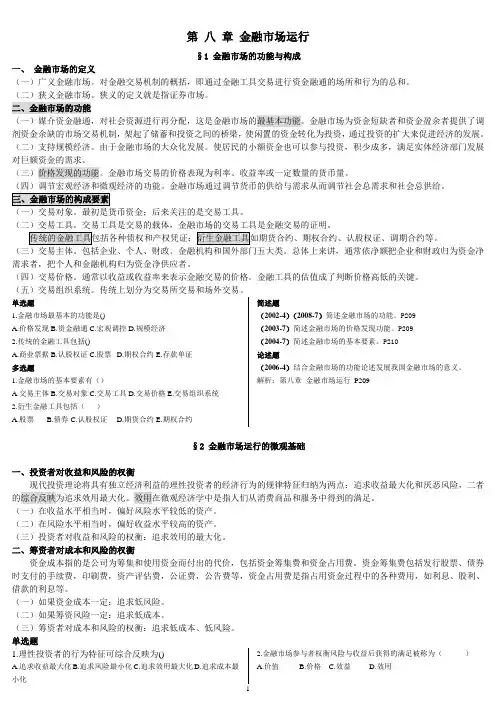
第八章金融市场运行§1 金融市场的功能与构成一、金融市场的定义(一)广义金融市场。
对金融交易机制的概括,即通过金融工具交易进行资金融通的场所和行为的总和。
(二)狭义金融市场。
狭义的定义就是指证券市场。
二、金融市场的功能(一)媒介资金融通,对社会资源进行再分配,这是金融市场的最基本功能。
金融市场为资金短缺者和资金盈余者提供了调剂资金余缺的市场交易机制,架起了储蓄和投资之间的桥梁,使闲置的资金转化为投资,通过投资的扩大来促进经济的发展。
(二)支持规模经济。
由于金融市场的大众化发展。
使居民的小额资金也可以参与投资,积少成多,满足实体经济部门发展对巨额资金的需求。
(三)价格发现的功能。
金融市场交易的价格表现为利率、收益率或一定数量的货币量。
(四)调节宏观经济和微观经济的功能。
金融市场通过调节货币的供给与需求从而调节社会总需求和社会总供给。
(一)交易对象。
最初是货币资金;后来关注的是交易工具。
(二)交易工具。
交易工具是交易的载体,金融市场的交易工具是金融交易的证明。
(三)交易主体。
包括企业、个人、财政、金融机构和国外部门五大类。
总体上来讲,通常依净额把企业和财政归为资金净需求者,把个人和金融机构归为资金净供应者。
(四)交易价格。
通常以收益或收益率来表示金融交易的价格。
金融工具的估值成了判断价格高低的关键。
(五)交易组织系统。
传统上划分为交易所交易和场外交易。
单选题1.金融市场最基本的功能是()A.价格发现B.资金融通C.宏观调控D.规模经济2.传统的金融工具包括()A.商业票据B.认股权证C.股票D.期权合约E.存款单证多选题1.金融市场的基本要素有()A.交易主体B.交易对象C.交易工具D.交易价格E.交易组织系统2.衍生金融工具包括()A.股票B.债券C.认股权证D.期货合约E.期权合约简述题(2002-4)(2008-7)简述金融市场的功能。
P209(2003-7)简述金融市场的价格发现功能。

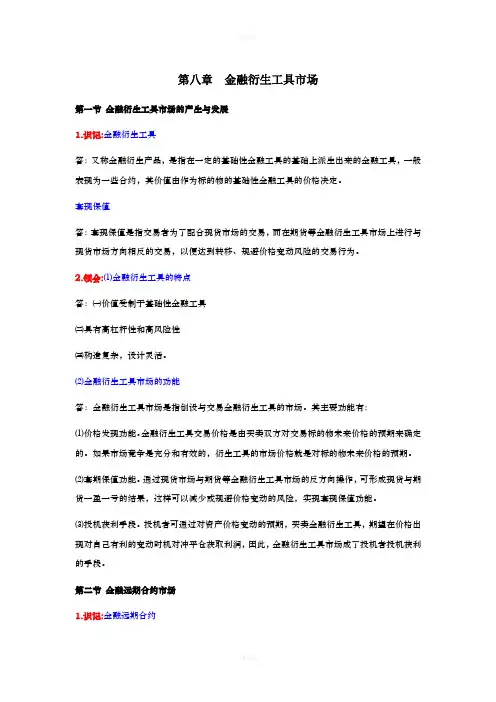
第八章金融衍生工具市场第一节金融衍生工具市场的产生与发展1.识记:金融衍生工具答:又称金融衍生产品,是指在一定的基础性金融工具的基础上派生出来的金融工具,一般表现为一些合约,其价值由作为标的物的基础性金融工具的价格决定。
套现保值答:套现保值是指交易者为了配合现货市场的交易,而在期货等金融衍生工具市场上进行与现货市场方向相反的交易,以便达到转移、规避价格变动风险的交易行为。
2.领会:⑴金融衍生工具的特点答:㈠价值受制于基础性金融工具㈡具有高杠杆性和高风险性㈢构造复杂,设计灵活。
⑵金融衍生工具市场的功能答:金融衍生工具市场是指创设与交易金融衍生工具的市场。
其主要功能有:⑴价格发现功能。
金融衍生工具交易价格是由买卖双方对交易标的物未来价格的预期来确定的。
如果市场竞争是充分和有效的,衍生工具的市场价格就是对标的物未来价格的预期。
⑵套期保值功能。
通过现货市场与期货等金融衍生工具市场的反方向操作,可形成现货与期货一盈一亏的结果,这样可以减少或规避价格变动的风险,实现套现保值功能。
⑶投机获利手段。
投机者可通过对资产价格变动的预期,买卖金融衍生工具,期望在价格出现对自己有利的变动时机对冲平仓获取利润,因此,金融衍生工具市场成了投机者投机获利的手段。
第二节金融远期合约市场1.识记:金融远期合约答:金融远期合约是指交易双方约定在未来某一确定的时间,按照某一确定的价格买卖一定数量的某种金融资产的合约。
远期利率协议答:远期利率协议是交易双方承诺在某一特定时期内按双方协议利率借贷一笔确定金额的名义本金的协议。
2.领会:⑴金融远期合约的特点答:⑵远期利率协议的功能答:第三节金融期货市场1.识记:金融期货合约答:金融期货合约是指交易双方同意在约定的将来某个日期按约定的条件买入或卖出一定标准数量的某种金融工具的标准化合约。
金融期货的标准化合约是指期货合约的合约规模、交割日期、交割地点等都是标准化的,即在合约上明确规定交易的规模、交割日期、交割地点等,无须双方再商定。

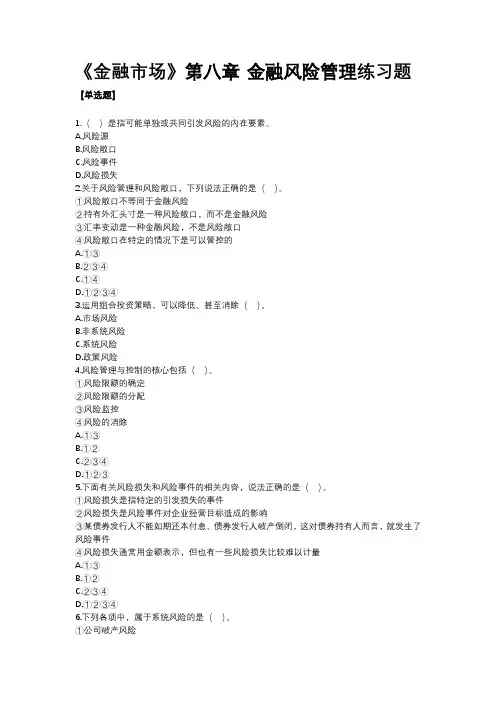
《金融市场》第八章金融风险管理练习题【单选题】1.()是指可能单独或共同引发风险的内在要素。
A.风险源B.风险敞口C.风险事件D.风险损失2.关于风险管理和风险敞口,下列说法正确的是()。
①风险敞口不等同于金融风险②持有外汇头寸是一种风险敞口,而不是金融风险③汇率变动是一种金融风险,不是风险敞口④风险敞口在特定的情况下是可以管控的A.①③B.②③④C.①④D.①②③④3.运用组合投资策略,可以降低、甚至消除()。
A.市场风险B.非系统风险C.系统风险D.政策风险4.风险管理与控制的核心包括()。
①风险限额的确定②风险限额的分配③风险监控④风险的消除A.①③B.①②C.②③④D.①②③5.下面有关风险损失和风险事件的相关内容,说法正确的是()。
①风险损失是指特定的引发损失的事件②风险损失是风险事件对企业经营目标造成的影响③某债券发行人不能如期还本付息、债券发行人破产倒闭,这对债券持有人而言,就发生了风险事件④风险损失通常用金额表示,但也有一些风险损失比较难以计量A.①③B.①②C.②③④D.①②③④6.下列各项中,属于系统风险的是()。
①公司破产风险②市场风险③通胀风险④利率风险A.①③B.①④C.②③④D.①②③7.下面关于风险的相关描述,说法正确的是()。
①纯粹风险是指只有损失机会而无获利可能的风险②投机风险是指既有损失机会又有获利可能的风险③流动性风险分为融资流动性风险和资产流动性风险④一般企业正常融资关系受到破坏属于资产流动性风险A.①③B.①④C.②③D.①②③8.信用风险会受到发行人的()等因素的影响。
①经营能力②盈利水平③事业稳定程度④规模大小A.①③B.①④C.②③④D.①②③④9.信用风险是()的主要风险。
A.债券B.股票C.衍生证券D.基金10.下面关于风险的相关描述,说法正确的是()。
①操作风险只可能带来损失,不能够带来收益②对操作的风险的管理策略是在合理的成本范围内,尽可能减少操作风险③声誉风险一般是受其他风险而产生的次生风险,很难确认和计量④市场风险包括股票价格风险、债券价格风险、商品价格风险、金融衍生品价格风险等A.③④B.①③④C.①②③D.①②③④11.风险溢价的大小与风险的高低成()关系。
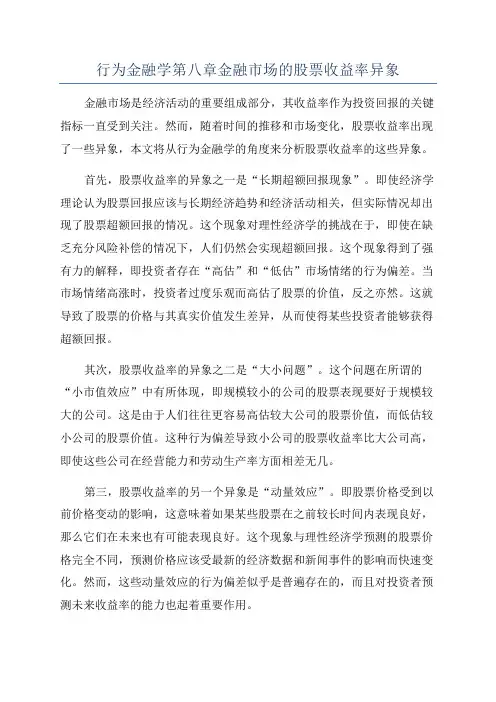
行为金融学第八章金融市场的股票收益率异象金融市场是经济活动的重要组成部分,其收益率作为投资回报的关键指标一直受到关注。
然而,随着时间的推移和市场变化,股票收益率出现了一些异象,本文将从行为金融学的角度来分析股票收益率的这些异象。
首先,股票收益率的异象之一是“长期超额回报现象”。
即使经济学理论认为股票回报应该与长期经济趋势和经济活动相关,但实际情况却出现了股票超额回报的情况。
这个现象对理性经济学的挑战在于,即使在缺乏充分风险补偿的情况下,人们仍然会实现超额回报。
这个现象得到了强有力的解释,即投资者存在“高估”和“低估”市场情绪的行为偏差。
当市场情绪高涨时,投资者过度乐观而高估了股票的价值,反之亦然。
这就导致了股票的价格与其真实价值发生差异,从而使得某些投资者能够获得超额回报。
其次,股票收益率的异象之二是“大小问题”。
这个问题在所谓的“小市值效应”中有所体现,即规模较小的公司的股票表现要好于规模较大的公司。
这是由于人们往往更容易高估较大公司的股票价值,而低估较小公司的股票价值。
这种行为偏差导致小公司的股票收益率比大公司高,即使这些公司在经营能力和劳动生产率方面相差无几。
第三,股票收益率的另一个异象是“动量效应”。
即股票价格受到以前价格变动的影响,这意味着如果某些股票在之前较长时间内表现良好,那么它们在未来也有可能表现良好。
这个现象与理性经济学预测的股票价格完全不同,预测价格应该受最新的经济数据和新闻事件的影响而快速变化。
然而,这些动量效应的行为偏差似乎是普遍存在的,而且对投资者预测未来收益率的能力也起着重要作用。
最后,股票收益率的异象之一是“市场反应迟钝”。
这个现象指的是市场对于一些新闻或事件反应的时间比理性经济学预测的时间长,这是由于市场上的投资者不是完全理性的,而且在某些情况下存在惯性投资者和过度自信的投资者。
这些行为偏差导致市场对于事件的反应需要时间,而且反应通常也是过分缓慢的。
总之,股票收益率的这些异象从行为金融学的角度阐释了人类行为在投资决策中的非理性之处。
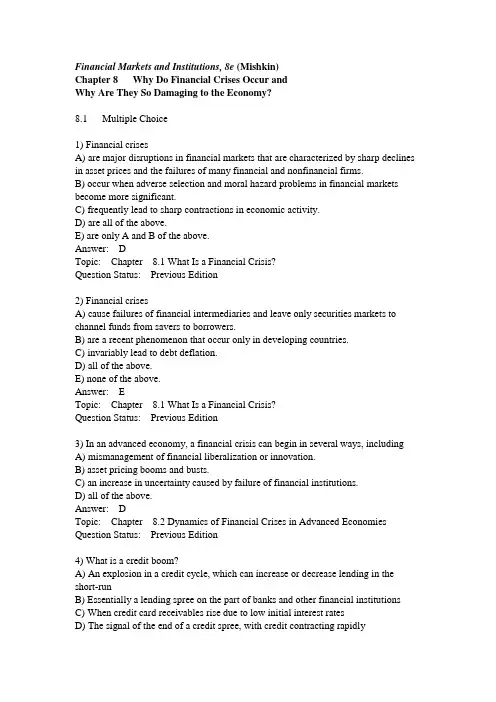
Financial Markets and Institutions, 8e (Mishkin)Chapter 8 Why Do Financial Crises Occur andWhy Are They So Damaging to the Economy?8.1 Multiple Choice1) Financial crisesA) are major disruptions in financial markets that are characterized by sharp declines in asset prices and the failures of many financial and nonfinancial firms.B) occur when adverse selection and moral hazard problems in financial markets become more significant.C) frequently lead to sharp contractions in economic activity.D) are all of the above.E) are only A and B of the above.Answer: DTopic: Chapter 8.1 What Is a Financial Crisis?Question Status: Previous Edition2) Financial crisesA) cause failures of financial intermediaries and leave only securities markets to channel funds from savers to borrowers.B) are a recent phenomenon that occur only in developing countries.C) invariably lead to debt deflation.D) all of the above.E) none of the above.Answer: ETopic: Chapter 8.1 What Is a Financial Crisis?Question Status: Previous Edition3) In an advanced economy, a financial crisis can begin in several ways, includingA) mismanagement of financial liberalization or innovation.B) asset pricing booms and busts.C) an increase in uncertainty caused by failure of financial institutions.D) all of the above.Answer: DTopic: Chapter 8.2 Dynamics of Financial Crises in Advanced Economies Question Status: Previous Edition4) What is a credit boom?A) An explosion in a credit cycle, which can increase or decrease lending in the short-runB) Essentially a lending spree on the part of banks and other financial institutionsC) When credit card receivables rise due to low initial interest ratesD) The signal of the end of a credit spree, with credit contracting rapidlyAnswer: BTopic: Chapter 8.2 Dynamics of Financial Crises in Advanced Economies Question Status: Previous Edition5) The process of deleveraging refers toA) cutbacks in lending by financial institutions.B) a reduction in debt owed by banks.C) both A and B.D) none of the above.Answer: ATopic: Chapter 8.2 Dynamics of Financial Crises in Advanced Economies Question Status: Previous Edition6) When asset prices fall following a boom,A) moral hazard may increase in companies that have lost net worth in the bust.B) financial institutions may see the assets on their balance sheets deteriorate, leading to deleveraging.C) both A and B are correct.D) none of the above are correct.Answer: CTopic: Chapter 8.2 Dynamics of Financial Crises in Advanced Economies Question Status: Previous Edition7) During the 1800s, many U.S. financial crises were precipitated by an increase in ________, often originating in London.A) interest ratesB) housing pricesC) gasoline pricesD) heating oil pricesAnswer: ATopic: Chapter 8.2 Dynamics of Financial Crises in Advanced Economies Question Status: Previous Edition8) Stage Two of a financial crisis in an advanced economy usually involves a________ crisis.A) currencyB) stock marketC) bankingD) commoditiesAnswer: CTopic: Chapter 8.2 Dynamics of Financial Crises in Advanced Economies Question Status: Previous Edition9) Stage Three of a financial crisis in an advanced economy featuresA) a general increase in inflation.B) debt deflation.C) an increase in general price levels.D) a full-fledged financial crisis.Answer: BTopic: Chapter 8.2 Dynamics of Financial Crises in Advanced Economies Question Status: Previous Edition10) Debt deflation refers toA) an increase in net worth, leading to a relative fall in general debt levels.B) a decline in general debt levels due to deleveraging.C) a decline in bond prices as default rates rise.D) a decline in net worth as price levels fall while debt burden remains unchanged. Answer: DTopic: Chapter 8.2 Dynamics of Financial Crises in Advanced Economies Question Status: Previous Edition11) Factors that lead to worsening conditions in financial markets includeA) increases in interest rates.B) declining stock prices.C) increasing uncertainty in financial markets.D) all of the above.E) only A and B of the above.Answer: DTopic: Chapter 8.2 Dynamics of Financial Crises in Advanced Economies Question Status: Previous Edition12) Factors that lead to worsening conditions in financial markets includeA) declining interest rates.B) anticipated increases in the price level.C) bank panics.D) only A and C of the above.E) only B and C of the above.Answer: CTopic: Chapter 8.2 Dynamics of Financial Crises in Advanced Economies Question Status: Previous Edition13) Most financial crises in the United States have begun withA) a steep stock market decline.B) an increase in uncertainty resulting from the failure of a major firm.C) a steep decline in interest rates.D) all of the above.E) only A and B of the above.Answer: ETopic: Chapter 8.2 Dynamics of Financial Crises in Advanced Economies Question Status: Previous Edition14) In addition to having a direct effect on increasing adverse selection problems, increases in interest rates also promote financial crises by ________ firms' and households' interest payments, thereby ________ their cash flow.A) increasing; increasingB) increasing; decreasingC) decreasing; increasingD) decreasing; decreasingAnswer: BTopic: Chapter 8.2 Dynamics of Financial Crises in Advanced Economies Question Status: Previous Edition15) Adverse selection and moral hazard problems increased in magnitude during the early years of the Great Depression asA) stock prices declined to 10 percent of their levels in 1929.B) banks failed.C) the aggregate price level declined.D) a result of all of the above.E) a result of A and B of the above.Answer: DTopic: Chapter 8.2 Dynamics of Financial Crises in Advanced Economies Question Status: Previous Edition16) Stock market declines preceded a full-blown financial crisisA) in the United States in 1987.B) in the United States in 2000.C) in the United States in 1929.D) in all of the above.E) in none of the above.Answer: CTopic: Chapter 8.2 Dynamics of Financial Crises in Advanced Economies Question Status: Updated from Previous Edition17) Which of the following factors led up to the Greece debt crisis in 2009-2010?A) Speculative attacks on the euro and a rise in actual and expected inflationB) A decline in tax revenues resulting from a contraction in economic activityC) A double-digit budget deficitD) All of the aboveE) only B and C of the aboveAnswer: ETopic: Chapter 8.2 Dynamics of Financial Crises in Advanced Economies Question Status: Updated from Previous Edition18) What is a collateralized debt obligation?A) A tranche of an SPV that has been setup based on default riskB) An agreement to exchange interest payments when one party defaultsC) A type of insurance against defaultsD) A contract between credit rating agenciesAnswer: ATopic: Chapter 8.2 Dynamics of Financial Crises in Advanced Economies Question Status: New Question19) Which of the following led to the U.S. financial crisis of 2007-2009?A) Financial innovation in mortgage marketsB) Agency problems in mortgage marketsC) An increase in moral hazard at credit rating agenciesD) All of the aboveE) only A and B of the aboveAnswer: ETopic: Chapter 8.2 Dynamics of Financial Crises in Advanced Economies Question Status: Previous Edition20) Approximately how large was the U.S. subprime mortgage market in 2007?A) $100 millionB) $100 billionC) $500 billionD) $1 trillionAnswer: DTopic: Chapter 8.2 Dynamics of Financial Crises in Advanced Economies Question Status: Previous Edition21) When we refer to the shadow banking system, what are we talking about?A) Hedge funds, investment banks, and other nonbank financial firms that supply liquidityB) The "underground" banking system used for illegal activitiesC) The subsidiaries of depository institutionsD) None of the aboveAnswer: ATopic: Chapter 8.2 Dynamics of Financial Crises in Advanced Economies Question Status: Previous Edition22) The impact of the 2007-2009 financial crisis was widespread, includingA) the first major bank failure in the UK in over 100 years.B) the failure of Bear Stearns, the fifth-largest U.S. investment bank.C) the bailout of Fannie Mae and Freddie Mac by the U.S. Treasury.D) all of the above.E) only B and C of the above.Answer: DTopic: Chapter 8.2 Dynamics of Financial Crises in Advanced Economies Question Status: Previous Edition8.2 True/False1) A financial crisis occurs when information flows in financial markets experience a particularly large disruption.Answer: TRUETopic: Chapter 8.1 What Is a Financial Crisis?Question Status: New Question2) Factors that can lead to worsening conditions in financial markets include increasing interest rates and asset price booms.Answer: TRUETopic: Chapter 8.2 Dynamics of Financial Crises in Advanced Economies Question Status: Previous Edition3) During a bank panic, many banks fail in a very short time period.Answer: TRUETopic: Chapter 8.2 Dynamics of Financial Crises in Advanced Economies Question Status: Previous Edition4) The failure of Ohio Life Insurance and Trust in 1857 did not signal the start of a recession due to prompt actions by the Fed.Answer: FALSETopic: Chapter 8.2 Dynamics of Financial Crises in Advanced Economies Question Status: Previous Edition5) Bank failures have been a feature of all U.S. financial crises from 1800 to 1944. Answer: TRUETopic: Chapter 8.2 Dynamics of Financial Crises in Advanced Economies Question Status: Previous Edition6) Debt deflation refers to the decline in debt values as creditors agree to lower interest rates as an alternative to defaults.Answer: FALSETopic: Chapter 8.2 Dynamics of Financial Crises in Advanced Economies Question Status: Previous Edition7) The Internet stock market bubble of the late 1990s led to one of the worst financial crises in U.S. history. Banks lost billions of dollars as Internet companies went bankrupt.Answer: FALSETopic: Chapter 8.2 Dynamics of Financial Crises in Advanced Economies Question Status: Previous Edition8) An unusual feature of the "Great Recession" in the U.S. from 2007-2009 was that the crisis did not spread to European nations.Answer: FALSETopic: Chapter 8.2 Dynamics of Financial Crises in Advanced Economies Question Status: New Question9) In Europe, Greece was the first nation to face a debt crisis.Answer: TRUETopic: Chapter 8.2 Dynamics of Financial Crises in Advanced Economies Question Status: New Question8.3 Essay1) Explain the relationship between agency theory and a financial crisis.Topic: Chapter 8.1 What Is a Financial Crisis?Question Status: New Question2) Describe the sequence of events in a financial crisis in an advanced economy and explain why they can cause economic activity to decline.Topic: Chapter 8.2 Dynamics of Financial Crises in Advanced Economies Question Status: Previous Edition3) What is the problem with government safety nets, such as deposit insurance, during the formative stages of a financial crisis?Topic: Chapter 8.2 Dynamics of Financial Crises in Advanced Economies Question Status: Previous Edition4) Discuss why some view the Fed as a culprit in the U.S. housing bubble during the 2000s.Topic: Chapter 8.2 Dynamics of Financial Crises in Advanced Economies Question Status: Previous Edition5) Describe a special purpose vehicle. How are they related to the creation of collateralized debt obligations?Topic: Chapter 8.2 Dynamics of Financial Crises in Advanced Economies Question Status: New Question6) Discuss some of the financial innovations in mortgage markets that led to the U.S. financial crisis in 2007.Topic: Chapter 8.2 Dynamics of Financial Crises in Advanced Economies Question Status: Previous Edition7) Why was the shadow banking system important during the 2007-2009 U.S. financial crisis?Topic: Chapter 8.2 Dynamics of Financial Crises in Advanced Economies Question Status: Previous Edition8) Describe how the European debt crisis evolved.Topic: Chapter 8.2 Dynamics of Financial Crises in Advanced Economies Question Status: New Question。
《金融学》第八章金融市场概述一、单项选择题(本大题共20小题,每小题1分,共20分。
在每小题列出的四个备选答案中只有一个是最符合题目要求的,请将其代码分别填写在下列表格中。
错选、多选、漏选或未选记-1分)。
1.狭义的金融市场就是()A.间接金融市场B.直接金融市场C.货币市场D.资本市场2.下列属于直接金融市场的是()A.国库券市场B.保险市场C.存款单市场D.信托市场3.下列属于间接金融市场的是()A.国库券市场B.股票市场C.中长期债券市场D.存单市场4.间接金融市场最主要的是()A.银行的借贷市场B.公司的借贷市场C.政府的借贷市场D.个人的借贷市场5.中央银行参与金融市场的目的是()A.获取盈利B.筹集资金C.套期保值D.宏观调控6.由于金融工具交易价格的波动而给其持有者带来损失的可能性属于金融工具的()A.信用风险B.市场风险C.操作风险D.流动性风险7.由于金融工具债务人不能履行还款义务而给其持有者带来损失的可能性属于金融工具的()A.信用风险B.市场风险C.操作风险D.流动性风险8.金融市场交易的对象就是()A.金融工具B.有使用价值的商品C.劳务D.服务9.下列属于资本市场金融工具的是()A.国库券B.商业票据C.大额可转让存单D.股票10.转换成货币时免受损失的能力是金融工具的()A.期限性B.流动性C.风险性D.收益性11.金融工具的本金在其存续期受到损失的可能性是金融工具的()A.期限性B.流动性C.风险性D.收益性12.下列金融工具偿还期为零的是()A.国库券B.商业票据C.股票D.活期存款13.下列金融工具偿还期为无限的是()A.国库券B.商业票据C.股票D.活期存款14.下列关于金融工具流动性表述正确的是()A.金融工具的偿还期限与流动性呈正方向变动B.金融工具的收益性与流动性呈反方向变动C.金融工具发行人的信誉程度与流动性呈反方向变动D.金融工具的风险性与流动性呈正方向变动15.将金融市场分为现货市场和期货市场的划分标准是()A.交易的金融工具期限长短B.交易的层次C.金融工具交割的期限D.交易的标的物16.将金融市场分为发行市场和流通市场的划分标准是()A.交易的金融工具期限长短B.交易的层次C.金融工具交割的期限D.交易的标的物17.下列金融工具中属于衍生金融工具的是()A.商业票据B.期权C. 债券D.股票18.将金融市场分为国内金融市场和国际金融市场的划分标准是()A.交易的金融工具期限长短B.交易的层次C.金融工具交割的期限D.金融交易的地域19.将金融市场分为有形市场和无形市场的划分标准是()A.交易的金融工具期限长短B.交易的层次C.金融工具交割的期限D.有无固定交易场所20.筹集资金是哪种金融市场的主要功能()A.发行市场B.流通市场C.外汇市场D.票据市场二、多项选择题(本大题共10小题,每小题1.5分,共15分)。
《金融市场基本知识》第八章金融风险管理第一节风险概述一、风险的定义目前金融学文献对“金融风险”并没有统一的定义。
根据考证目前国内外关于风险的定义多至14种,其中主要的有以下几种。
(一)风险是结果的不确定性这种观点认为风险等同于结果的不确定性。
不确定性是指人们对于事物的未来状态不能确切知道或掌握,也就是说人们对事物未来的发展变化缺乏信息与掌控力。
按照这种定义,风险的存在就是不以人的意志为转移的客观事实。
(二)风险是波动性或对期望值的偏离度多数流行的投资学教科书采用马科维茨的“均值—方差理论”分析框架,认为金融变量(如利率、汇率、股价等)会围绕期望值波动,波动性就是风险。
因此,风险被定义为对期望值的偏离程度,并用标准差、方差、半方差等统计变量来测度风险。
按照这种定义,风险是一个中性概念,并不等同于损失。
将风险与波动性联系起来的观点实质上是将风险定义为双侧风险,实际结果对期望值的偏离既可能出现不利结果(例如股价未预期的下跌,即下侧风险),也可能出现有利结果(例如股价出现未预期的上涨,即上侧风险)。
(三)风险是不确定的不利因素或未来损失的可能性这种定义的优点在于突出了风险带来的损害(下侧风险),而将盈利机会排除在外,是典型的单侧风险的概念。
这个定义在实践中运用比较广泛,例如风险测度与控制指标中常见的最大回撤、风险价值(VaR)、压力测试等等都是出于对可能损失的考虑而设定的;同时,监管文件和企业内部风险控制政策也强调了损失可能性意义上的风险。
(四)不确定性对目标的影响中国国家标准对风险定义的完整表述如下:“风险Risk不确定对目标的影响。
注1:影响是指偏离预期,可以是正面的和/或负面的。
注2:目标可以是不同方面(如财务、健康与安全、环境等)和层面(如战略、组织、项目、产品和过程等)的目标。
注3:通常用潜在事件或后果,或两者的组合来区分风险。
注4:通常用事件后果(包括情形的变化)和事件发生可能性的组合来表示风险。